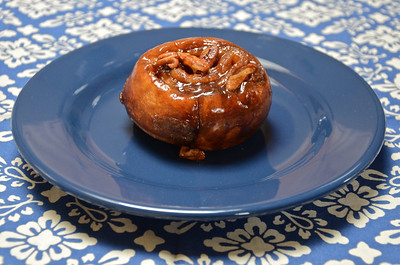
The past few Saturdays my morning ritual has been to throw on some clothes and hustle over to our neighborhood farmers’ market. My mission? To get there before someone else buys all of St. Peter’s Bakery’s brioche sticky buns. Thanks to their rich yet light dough, these brioche-based buns are the most divine that I’ve ever eaten.
Rumored to have originated in Normandy, France in the Middle Ages, brioche is a light yeast bread or cake made from flour, butter, eggs and, of course, yeast. Its name comes from the verb broyer, meaning to break up. The breaking up refers to the dough’s need for repeated and prolonged kneading.
In addition to increased kneading, brioche usually requires three, rather than just two, rising periods. In France this extra time and effort has prompted most to buy, rather than bake their own, brioche. Shops devoted to brioche, known as viennoiseries, have sprung up to serve this need.
In the 19th century it became the custom to bake this dough in a deep, fluted pan. The resulting bread possessed a narrow base and a wide, pillowy top. While this form still exists, I more often encounter the Parisian version. Instead of using special pans, Parisian bakers place small balls of dough atop larger ones, creating what is known as brioche à tête or ‘brioche with a head.’ Along with brioche à tête I also have seen brioche loaves, plaits and buns.
As it’s a versatile dough, I’ve come across brioches filled with fruit, cheese, nuts, meats or whipped cream. In any case, it’s traditionally consumed at breakfast or as a snack with a cup of coffee, tea or hot chocolate.
BRIOCHES À TÊTE
From Baking at Home with the Culinary Institute of America (Wiley, 2004)
Makes 24 individual brioches
NOTE: Brioche dough will keep for up to 1 week in the refrigerator and 2 months in the freezer.
5 cups flour, plus extra as needed
2 1/2 teaspoons active dry yeast
4 large eggs, plus 1 beaten egg for brushing
1/2 cup whole milk
1/4 cup sugar
2 teaspoons salt
3 sticks unsalted butter, diced, at room temperature
cooking spray for greasing
Combine the flour and yeast in the bowl of a stand mixer fitted with a dough hook. Add the eggs, milk, sugar and salt and mix on low until evenly blended, scraping down the bowl as needed, about 4 minutes.
Gradually add the butter with the mixer running on low speed, scraping down as needed, about 2 minutes. After the butter has veen fully incorporated, increase the speed to medium and knead until the dough begins to pull away from the sides of the bowl and is quite elastic, about 15 minutes.
Remove the dough, shape into a brick, wrap in plastic wrap and refrigerate for at least 8 hours.
Coat individual brioche tins or muffin pans with cooking spray.
To shape the brioche, remove the dough from the refrigerator and cut into 24 equal pieces, about 2 ounces each. Preshape each piece by rolling it into a 3-inch long cylinder. Coat the edge of your palm with flour and then roll the dough back and forth about 1 inch from the end of the cylinder to create a head (tête) that’s still attached to the dough; it should look like a bowling pin. Transfer the brioche, head up, to the mold. Hold the head with fingertips of one hand and push it down against the larger portion of the dough so that the head sits on the surface of the brioche. Brush lightly with egg wash. Repeat until all the brioches are made. (If the dough becomes too sticky, return to the fridge until chilled.)
Cover the brioches with a clean, damp towel and allow to rise until nearly double in size, 1 1/2 to 2 hours. Meanwhile, preheat the oven to 375 degrees Fahrenheit.
Brush the brioches with beaten egg once more before baking. Bake until golden brown, about 15 minutes. Let cool in tins or muffin pans for 10 minutes. Unmold and finish cooling on wire rack before serving.